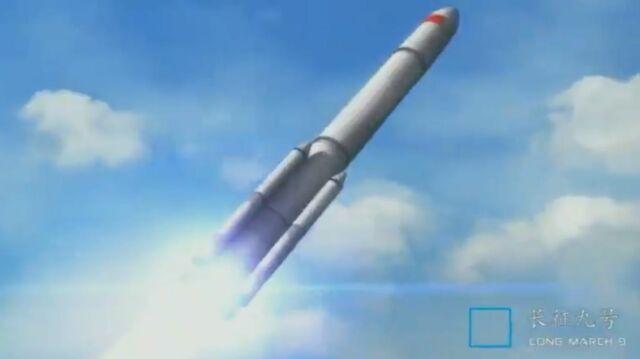reader comments
244
with 118 posters participating
Share this story
Share on Facebook
Share on Twitter
Share on Reddit
China released this low-fidelity render of its Long March 9 rocket launching.
It appears to lift off from a tropical site, to take advantage of higher equatorial velocity.
The rocket consists of a large 10-meter diameter core stage and four side-mounted boosters.
The Long March 9 is planned to have a capacity of 140 tons to low Earth orbit.
Nice Korolev Cross as the boosters separate.
China wants to make the rocket reusable, although that may be difficult if the side boosters are solids.

China has officially approved the development of a super heavy lift rocket, named the Long March 9, or CZ-9 vehicle. The decision was revealed on Wednesday by Chinese state television.
Further Reading
China set to launch an ambitious lander mission to Mars
In
a snippet from an interview
with CCTV, the deputy director of the China National Space Agency, Wu Yanhua, said the main purpose of the new rocket is for any "crewed lunar landing or crewed Mars landing missions" the country may undertake.
According to Chinese officials, the country will target the year 2030 for a debut launch. This is consistent with previous timeline estimates. The rocket is planned to have a lift capacity of 140 metric tons, with the capability of sending 50 or more tons into lunar orbit. It would be an immense vehicle, with a 10-meter diameter core and 5-meter side boosters. China would also like to eventually make the rocket, or at least part of it, reusable.
Advertisement
The prospects for the long-rumored CZ-9 super heavy lifter came under some doubt last year, when
China said
it was also considering development of a triple-core rocket that would have a similar appearance to two US rockets, SpaceX's Falcon Heavy and United Launch Alliance's Delta IV Heavy. For now, at least, it appears that China is pressing ahead with both, with a 2025 launch target for the triple-core design.
The target date of 2030 for CZ-9 might seem distant for rocket development, but it would be relatively speedy compared to NASA's design and construction of the Space Launch System rocket, which began a decade ago. The initial configuration of the SLS rocket will have a lift capacity of 70 to 85 tons and may launch in 2022. Only after two additional major updates—likely to cost about $20 billion and not to be completed before 2030—will NASA's rocket have a lift capacity of about 130 tons.
China's announcement offers a powerful statement of its intent to press ahead with human deep space exploration. The country has already talked in generalities about establishing a Moon base in about a decade, but this appears to be the first time the country is also expressing an interest in sending humans to Mars as a follow-up mission.
Listing image by CCTV









